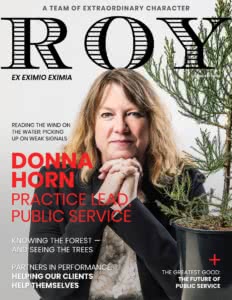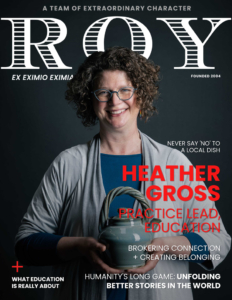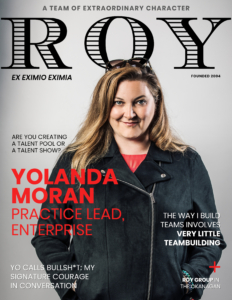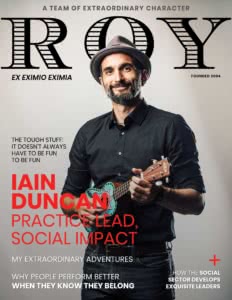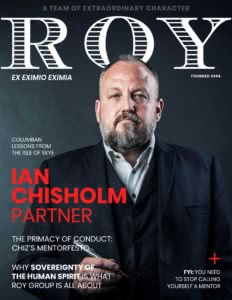Every now and then, a leader’s candid insight makes our hearts skip a beat. This month, we bring you an in-depth conversation with Margo Long, one of the most perceptive and unguarded humans we know. (She’s also ultra-competent, having steered her organization to surpass its five-year strategic targets in a mere three.)
Margo traded her corporate job to head up an Edmonton social service organization where she had little practical experience, so that she and her team could make life safer and softer for youth who are already on that slow, terrifying slide toward homelessness.
As an original (edited) interview, our conversation with Margo adds context to the case study we recently sent you.
Self-reflective, gifted with strategic insight and unafraid to talk about her own struggles on the path of leadership, Margo embodies the humility, discipline and rigour of practice we most admire in leaders.
Don’t have time to read the whole interview?
Here are three key takeaways:
1. Sometimes we forget that EQ is a privilege.
We’re told to hire for EQ. But who has EQ, anyway? People who have had the privilege of safe, positive learning experiences. It is usually not people from tough backgrounds, yet they’re often the ones who gravitate to working in the social sector because it’s personally meaningful. These folks need leadership development training to properly support the complex, emotional work they are doing.
2. If you trust people who do great work…they’ll keep doing great work.
Same is true for charities. We don’t have to tell them how to spend their money. (How absurd for an overseer to dictate how your business should spend yours?) They know what their clients need best.
3. Crisis is exactly when you need good leadership skills.
People are quick to cut leadership development when times get hard. But that’s when you need the tools the most. When the world needs you needs to be masterful…it’s too late to start practicing.
* * *
Going long with Margo Long, President and CEO of YESS
Tell me a little bit about what YESS does.
Absolutely. YESS—Youth Empowerment and Support Services—provides a low barrier, 24/7 shelter, supportive housing, transitional living and wraparound resource support for young people experiencing crisis and housing instability in Edmonton. Typically, they’re aged 15 to 24. We’re focused on prevention—what they call late prevention—where our goal is to prevent further entrenchment into crisis and housing instability.
Can you expand on what you mean by “housing instability”?
Yeah. There are different schools of thought. The term conveys a true sense of instability, as opposed to the label of “living on the street”. We use “housing instability” because often, young people are hidden in their housing instability. They’re sleeping on couches with friends, they’re moving from area to area. They’re not necessarily sleeping under a bridge, but they also don’t have a stable housing situation.
Let’s talk about how YESS’s impact has deepened through Power to Give. For our readers, Power to Give is a granting foundation that provides unrestricted funds to charities to use as they see fit—instead of telling them how the money should be spent. What’s the nature of your relationship with Power to Give?
I started working with Power to Give in 2019 through a funding relationship. Like you say, they have a unique philosophy that’s really progressive. They educate funders on the importance of trusting charities and social service groups to do the work they’re doing, and to use the money where they see best, on projects that are impactful. It’s really about learning about the organization, trusting the work that they’re doing, and trusting them to really focus the funds on where it belongs. We do talk about what the funding is going to support, but taking out a lot of the cumbersome red tape and the often ambiguous or random outcome-reporting that a lot of funders demand that can be really onerous.
My understanding is that the work of constantly writing reports for funders often taxes organizations to the point where they’re actually spending more money reporting on things than they are on doing the work they’re supposed to be doing. Most people don’t know this.
Exactly. From my perspective, the current funding landscape is short-term. It’s directed by either political influence or by people who aren’t frontline, who don’t have visibility to the actual problems, which is not good continuous improvement. Continuous improvement is about involving the people who are doing the work and making those changes to the system. It’s not about somebody who’s not in the system overseeing it and making the decisions. That’s short-term thinking. It’s also not sustainable. Funders put the sustainability back on the organizations—How are you going to take this funding, this capability and keep growing it?—which makes us compete as if we were businesses, when we’re not. We don’t sell commodities. We’re often serving the same needs between our organizations. In our funding grants, we’re asked how we’re going to collaborate with people (who we maybe just beat out for funding) and how we’re going to sustain the $10,000 they gave us to start a new program…without any salary money. Those are the challenges that we face with funders.
Charities have to fight for grants. And then work together to deliver services.
And prove that they can keep the thing going, without further support. I was lucky enough to receive funding from Power to Give in 2019, and it was quite transformational for our organization. I took over YESS in 2017—I came from business, which is where I had met Roy Group. When I took over this organization, it was in trouble. It was not financially sustainable. In 2017–2018, we really had to lower our operating budget, stop the bleeding, look at our staff and really clean house. That meant that in 2018, we were behind six months in terms of revenue generation. It was quite an unsettling time for us. We knew that what we had invested in was going to get us to the next stage. We knew we had the right strategy, we had the staff in place, but we had probably a six- to eight-month runway and we were significantly in debt. I appealed to Power to Give to support us through that year, which has made all the difference for us in giving us that stability and strength to grow our foundation.
How so?
My goal was to get to a place where we actually had our operating budget in the bank—at least six months of it. Which was not the case at that point. We were starting each year with zero, as charities often do, or else we were in debt, which is just not sustainable. This is where Power to Give believed in our strategy. It was not just a loose belief: They’re good people doing good things. They actually saw that we were being strategic. Looking at root causes. They could see that we had in place the mechanisms to become financially sustainable. Their investment gave us a stronger poker pot to make better choices during COVID, for one. If we had been $750,000 in debt (which we were in 2018–2019) we would not have made it through COVID the way we did. This belief in an organization’s strategy and what they’re setting out to do, and trusting the organization to set the outcomes that are appropriate, is empowering and I believe more responsible.
You say it’s more responsible.
It’s interesting. That behaviour of trusting is very much within Roy Group methodology and Tim Gallwey. Trusting us to have the skill and the will, and coaching us if there was anything in our way, but to really allow us to self-determine, and believe that we could self-determine and self-adjust through this and make our own decisions. Power to Give is walking that walk in true Roy Group fashion, and that’s made all the difference. That support from Power to Give set us on a trajectory where now we’ve reached all our strategic goals. We’ve surpassed them, actually. And that was a five-year goal. It’s supposed to be done in 2023, and we’ve already reached those financial goals. We’ve started investment accounts and endowment funds to build automated revenue for ourselves.
Wow. You don’t hear charities saying that very often.
And we’ve been able to really focus on this transformational change internally to build collaboration with other agencies in the city-wide model—the first of its kind—and to really embed a trauma and healing lens into the process, because that’s not something that’s been intentionally built into our system at all. It has let us do the work we need to do, knowing that we’re OK, and it has allowed me to build up financial sustainability quickly.
What was your prior business experience?
I was a business and marketing strategist. I did strategy for both businesses and social service organizations.
So Power to Give provided you with unrestricted funding—money for YESS to use in whatever way you understood it to have the greatest impact. And how does your work with Roy Group fit in?
Power to Give brings Roy Group in to work with the organizations it grants money to. Once a year, Power to Give brings us all together somewhere for a retreat, and Roy Group facilitates leadership development conversations and learnings. Some of us, like YESS, also work with Roy Group directly in our own organizations. It’s easy to identify a Roy Group organization by the way they walk. And if they’ve truly started to embody it, you can see familiar “family members” within that quickly: Oh, yeah, you get this. And that’s with Power to Give as well. You can tell because they are acting on those principles of the dignity behind organizations to self-determine and make those adjustments, and that the role of Power to Give is to give feedback. To ask what’s getting in the way. And to coach.
So you met Roy Group through Power to Give?
No, our origin story is a bit different. Roy Group actually introduced me to Power to Give! My relationship with Roy Group started back in 2008, through the business and marketing company, Incite Strategy.
We still have a close relationship with Incite! Chiz and Ted are good friends. And Darren, who’s also a partner, works with us on our materials. They’re good people.
I was a partner and strategist with Incite for 10 years. In 2008, the two owners—who were young men at the time, not even 40—had this growing company that went from a flat organization to a hierarchy, and they started to acknowledge that they needed to build leadership in their leadership team. Some of the signs that they needed support were pretty common flags: micromanaging, an inability to let go of control, not understanding the dynamics of coaching.
We see this all the time in organizations.
So we went looking. And Fountain Tire, who were trusted friends of ours, recommended Roy Group. My leadership training started with The Leader’s Discipline™ as an executive group, where we met Ian and Bradley [Ian’s brother] and Anne-Marie. That relationship became mutual over the next 10 years: Roy Group became our clients as well as us being their clients. When they came to us, their visuals were terrible and a lot of their stuff needed support. I had the honour of being their strategist on the website and on content and some of those things. And actually, Bradley and I initiated the system of stickers that Roy Group uses to this day.
Well, we’re grateful for that early steering, Margo! How are our materials now?
Better! And at Incite, we were so excited about the capacity that we could see building within us as a team—the philosophy and the enticement of building a leadership design for coaching, and building an organization designed for leadership. Building a coaching organization! We made sure all the staff had Roy Group training, and over time, we became a coaching organization designed around the Roy Group principles.
You actually took the tools and applied them and made it work. We get really excited when our clients do that.
It was such a powerful tool in my leadership. I had the benefit of going through all of the Roy Group courses, doing personality tests, really looking at: What is it time for? in my leadership during that period between 2008 and 2017.
So…and in 2017 you took over YESS. What was behind your move from business to the social impact sector?
There were two things. Number one, I am a changemaker and a continuous improver, and it’s really hard to do that as a consultant. It is so difficult to make recommendations and not see the implementation through. And the second thing was around wanting my own team. As I prepare for succession at YESS, I realize I value teams the most, and leading teams. I don’t even think I knew that leaving Incite. I feel like I had no business taking over a bigger company than the one I’d just left! But I did it, and I learned a lot. And I made a lot of mistakes about being a leader. And I realized this is where I want to be. I get the most juice and inspiration and energy when I can work with a group of people and collaborate and figure out how to do something together.
That fits with Roy Group’s work. Figuring out how to do something together. Playing for each other.
Yeah, the first month after I joined YESS, I knew that I needed Roy Group. I knew that to do the big, ambitious work that we wanted to do, we needed the Roy Group leadership philosophy, tools and methodology. Social services need this more than anyone. A lot of the skills of leadership get taught in business school. They get taught in universities. They get taught in for-profit businesses: when you become an employee, they invest in that training for staff. That’s not something that typically happens in social service organizations. And a lot of that comes from the influence of boards and donors who, misunderstandingly, think that it’s an administrative cost that’s not necessary. And that’s garbage. These tools and methodologies and the philosophy are more important than ever in an organization that’s dealing primarily with humans, not profit.
I don’t think that’s a view most people have considered. Tell me more of your thinking.
Often in social service we attract people with lived experience. We attract people who have gone through trauma as a child or as a youth, who’ve worked at YESS before, who have significant emotional issues around some of this stuff. That’s why they’re drawn to help! But not everyone has learned how to regulate their emotions. Not everyone has learned how to be confident and believe in themselves. We get a lot of imposter syndrome in social services. Those emotional ego issues from past experiences get in the way of the deep work that we want to do. For example, youth workers—youth workers are an incredible bunch of people who are so hidden and invisible in the value system of our society—might be concurrently parenting, doing CPR or administering naloxone, probably also dealing with some suicide ideation and maybe creating suicide plans, doing homework, talking about boyfriends, all in a night.
Even one of those is a big assignment when you’re dealing with at-risk youth, never mind all of them.
And they’re often the least paid, most junior people in the staff. When I think about my parenting journey, I was very grateful that at least I was in my 40s and had some life experience to deal with some of these things. And we’re often throwing them right out of school into these organizations.
How does the lack of leadership skill show up?
In the interpersonal. Having difficult conversations. Not taking things personally. Being able to regulate when they’re triggered or feeling unsafe. Trauma-informed care, which is a best practice that many youth agencies and social services use, is very similar to the Roy Group philosophy. It’s about creating space and safety, being explicit about what you need, setting boundaries, giving data and feedback around things, and coaching people through what their own barriers are.
The methodology works everywhere.
Yes. In the beginning, we were spending so much time on interpersonal conflicts between staff. Whether it was fund development or facilities, there was a lack of empathy and communication, which is pretty normal for any organization, profit or not. It escalated very quickly in this organization because of those emotional pieces. And we were also trying to change a culture that was quite damaged. There was disempowerment and there was fear of leadership coming down hard or yelling or punishing, so people didn’t feel safe. They didn’t know what their role was. And they certainly didn’t see themselves as leaders. With the previous leadership, it had very much been a “role” and a privilege to be a leader. You know, you get the nice parking spot. The concept of leadership wasn’t based on the types of decisions you make on a day-to-day basis.
How have you embedded Roy Group practices into YESS?
I’ve prioritized this training so that even when we didn’t have budget for much, we had budget for Roy Group. Even during COVID, when we cut our budget to predict a 75% loss of revenue, I kept Roy Group. I knew we were going to need it. Again, that’s something that Power to Give has supported us through. It’s easy to make the decision that you don’t need it. It’s like marketing, it’s like strategy…when you’re doing well, you think about these things that support your broader ability to function—but that’s not when you need them.
It’s in crisis that you need these things.
Yeah. Luckily, we had started this process when the pandemic struck. We had already started with our Leader’s Discipline, putting one group through the first year, the next group the second year, and then we did recharges where we brought the two groups together so that we could really start talking about that next piece: How do I start taking this into the organization? How do you go from a training session into regular practice? It was in those discussions as a group about: How are we going to live this? Where do we see us using a feedback model? When is coaching valuable?
What processes or tools really aligned for your team?
Wise Council really resonates with everyone and empowered them very quickly, so that was one of the first things that we started to work with.
What has your work with Roy Group helped your team to do?
It’s taken three years, but what I’ve noticed is that now we’ve got leaders. We have directors. We have an executive, and then we have managers, supervisors and staff. We have roles, but we also have people making leadership decisions at every level. The first thing I did when we started with Roy Group was to get my executive team trusting and on board so that they could start disseminating this. I also put us through a Focus on Self in the summer of COVID. We’d spent the first three months of COVID crying, yelling at each other, upset, scared, because you just don’t have the tools. What we call personality flaws are really just not having the tools and understanding in space and time to build resiliency. Especially with the work that we’ve been doing in understanding how to support racialized and 2SLGBTQIA+ staff and youth, it’s become very clear to me that resiliency and leadership skills are a privilege.
What’s your thinking there?
HR and recruitment firms say all the time that we should be hiring for EQ. Well, who has EQ? It’s those that have had safe upbringings and positive reinforcement and have had the space and time to build these resiliency tools. Who is that? It’s the privileged. If we want a strong organization…like, we’re going to change the world, but if we’re going to do that, we need to be able to take care of ourselves, to take care of our youth and the organization. Hierarchy is a level of mentorship. What we’ve really learned is whatever we are going to do for the youth, we have to do for the staff, because they are the Mentors and models. They’re the parents for these young people. Often they’re the same age as the youth they’re serving, and they’re out there working with the agencies trying to get the same income supports or housing supports for themselves as for their clients. If you build the Roy Group practice into the staff, their practice then automatically gets built into the work that they’re doing. You have to start there first. We need to practice and have those skills and be a dynamic team. And that takes a ton of work, it took more work than anything else. Still takes more work.
Yes. It’s doing the work that makes it all work. The discipline. The practice.
What I’ve noticed now is that instead of individuals who in the past have maybe had a hard binary—That person is too hard, I don’t want to work with them—they’re now saying things like, You know what, I’d like to take six months, I’d like to coach, I’d like to really take a focus on helping develop this individual through my own leadership practice. I’ve seen people start holding feedback meetings after big events. We just had our CARF audit, which is our international accreditation body, and after we did the audit, we had a feedback meeting. That’s not something I booked. It’s so incredible. When you start laying that foundation, you start getting the buy-in and then it starts happening all on its own.
Let’s talk about the Social Impact Retreat. For our readers, this is an annual gathering of social impact orgs, hosted by Power to Give—always in a restorative place, like Fogo Island Inn or the Wick in Tofino or Arowhon—and facilitated by Roy Group. The idea is to bring leaders of these organizations together so that they can be a little spoiled for once, and so they can build relationships across sectors and improve their leadership skills. What is the impact of that retreat?
I’ve never been so lonely as being a leader of a social impact organization and not having peers to talk to, support, innovate, collaborate. There’s quite a bit of vicarious trauma in my job, whether it’s crying staff, losing youth on a regular basis…there’s a lot of trauma and without an outlet…and without really having an understanding of where it was affecting my leadership and my self-care… Going to the social impact retreat was transformational for me. It’s incredible to just be nurtured. You know, it’s hard sometimes to even accept the kinds of lavish comfort and support they give through the space and the food and all of these incredible things. But I was able to start feeling like it was OK to nourish myself, because I could see that my leadership was suffering. It gave me perspective. It took me away. I got out of the weeds and was able to look back, and I was able to see what everyone else was going through. It gave me perspective on What is going on with my leadership? What are some of the red flags around how I behave when I’m under stress or in crisis?
What were you able to see as a result of having some distance and rest?
Roy Group often asks: What is it time for? And in my leadership stories, I realized that I kept stopping at the “celebrate” part of the hero’s journey. I wasn’t celebrating. I was already on to the next thing. And I stopped letting myself experience joy, because I kept feeling like I didn’t deserve it when everyone else was suffering.
People who work in the social sector so often pour from an empty cup: How can I justify giving to myself when others have so much less?
And that was actually being pushed onto my staff. Some pretty negative leadership flavour for me there, as I realized my own not taking care of myself was actually affecting the way I was helping others. It gave me so much perspective to really focus on, What do I need in my leadership for myself? And what does everybody else need? The retreat also gave me so many ideas for collaboration and support with the other leaders there. I feel like I have a peer group of CEO colleagues, EDs who are brilliant, who are so compassionate. They can hold me in that space of, I’m exhausted and I just need to come apart in front of someone that doesn’t need me to be strong. And because we have all had Roy Group training, they can help me through some of the thought processes and work. But they’re also there for that operational dialogue on: Hey, if you’ve got a policy on this, could I have a look? It’s just been incredible.
Retreats like this in the social space are rare. Like you said, society has this expectation of charities to solve massive socioeconomic and environmental issues…but keep it cheap, please. Whereas in the corporate sector, leadership development is perceived as essential for optimal performance. These kinds of experiences are seen as valuable for the for-profit sector, and they are made available.
All the time.
How does the leadership development you’ve been doing with us support innovation and collaboration at YESS?
Innovation comes when you need to solve a problem together, but you need lots of perspectives. In order to get lots of perspectives, you need to be able to work together, you need to hear them, and you need people to feel safe talking about them and coming up with those ideas. You need an ecosystem that’s safe for innovation, and that means there needs to be honesty. There need to be safe-to-fail situations as well. COVID really helped me with that, because I leaned on my knowledge of the Cynefin framework and the stuff from Cognitive Edge that Roy Group taught me.
That in complex times, there are no experts and there is no procedure.
None. And often when people don’t have the tools to think for themselves, they follow the procedure and then it goes horribly wrong because it’s not a perfect match—the situation is more complex than whatever that particular procedure is designed to address. In complexity, we don’t know what’s going to happen. We have no experts, which means we can experiment. Nothing fails because it’s all education. We sense what works and we go from there. I’ve used that language when we were trying things. We experimented and innovated like hell through COVID! Coming up with some of the coolest stuff, and overcoming a lot of risk aversion that had been with our partners in the past (worry about us being territorial or overtaking). The atmosphere was there, and with this statement around, Look, we’re just experimenting right now and we’ll learn things and we’ll learn what works and we’ll start doing more of that. We’ll try some other things. It really gave people space to come up with problem-solving small experiments.
That’s very cool.
The essence is that there are no experts, and so you just try shit.
We did that too during the pandemic.
Of course you did.
Lotta experiments. Do you have more to say on that innovation piece?
We’ve made some pretty incredible accomplishments—aside from reaching all of our strategic goals in three years. During COVID, we were the first people to respond. We wrote all our policies and we shared them with everybody else. We saw a problem: in our city, people experiencing housing instability or homelessness were supported at our Expo centre, but it was adult-based. Nobody had thought about youth at first. So leveraging some of the collaborative trust we built over the last four years, we took a swing at a solution.
Which was?
We opened up one of our houses as an isolation space. And we provided isolation to the entire city, including transportation. It worked because people felt safe—it was safe to try things out, it was safe to talk about what was working and what wasn’t. We were able to c0-create something called the Coordinated Youth Response during COVID that found money, got a contractor consultant, built a platform, and we now have thirty-five agencies working together on this platform to share information, connect youth to basic needs, isolation and screening during COVID. And that was huge. Including schools and Edmonton Public Schools and Children’s Services and partners that we haven’t collaborated well with in the past. But because we prioritize leadership and collaboration at every level, that means I expect our team to be collaborating with other agencies just as much as I am, and building out those leadership tools in the work that they’re doing with other agencies. Different individuals have started to see their own leadership, have started to see where they fit into this, and are building those relationships. Coming back to coaching, feedback, difficult conversations, and really being clear about our intentions and the atmosphere we create through our interactions with other people.
That is a huge moment, eh? When you realize that the impact of your organization has mushroomed because people now take the ball and run with it? They know that their leadership will be supportive of them as long as they’re philosophically aligned and are conducting themselves in a way that marries back to your values.
It’s huge. In the past, I was called in to mediate things at YESS. It was at the executive level that we would make decisions around solving problems—which was still micromanaging, in my opinion. Now what’s happening is managers are coming to us and saying: Hey, we had a meeting, this didn’t work. Now we’re doing some continuous improvement. Here’s our plan. Here are some of the ideas that we have. What do you think? That is a huge difference from a personal issue of somebody coming in and saying: So-and-so is doing this and I don’t like it! And then me stumbling through, trying to figure out how to navigate that. Now they’re making leadership choices in their own departments and with their own peers on a regular basis.
This is interesting. In our case study with Rocky View Schools, their head psychologist said the same thing. He used to be called in to mediate and to resolve disputes, and now that’s not happening. Like, people are now able to work through conflict because they have the tools to do so.
And HR! That’s the other sign, is when fewer people are going right to HR for grievances when it should have been a conversation. That’s not anywhere close to as much anymore. Where people are having conversations with their peers, having feedback meetings, they’re not even involving senior leadership. They come up with something.
It gets resolved.
Yeah. One of the cool things that has happened in this evolution of Roy Group leadership bubbling up in different ways, and the compatibility with trauma-informed care and boundaries and the training that we give our staff, is that we have a psychology team that focuses on both the youth and our staff. The wellness practitioner that focuses on staff works with each department throughout the year, and she does a wellness SWOT with them. She runs through what trauma-informed care means for each department. It’s different in administration than it is in fund development than it is in the kitchen. They talk about how they see themselves and the role. She works through their own personal values as well as the team values. She talks through self-care and what that looks like from a team focus, so that people can help hold each other accountable. Or helping them understand red flags in a teammate’s conduct—maybe they’re overloaded or they’re exhibiting ego behaviour—so that they can ask themselves, What does this person need and how I can support them? We’re actually going to work with Iain Duncan to see how we take that into the organizational values with some charters so that we are holding each other accountable as teams. We’re even going to have Iain do some supercoaching of our teams to see if they, in their meetings, actually adhere to their values. It’s also really shone a light on our performance management evaluations and monthly supervisions. Now that everyone’s gone through The Leader’s Discipline, we are going to spend this year working with Iain and ourselves on: What does that monthly check-in / yearly review look like, according to our trauma-informed principles, as well as the tools and methodology and philosophy at Roy Group? We hope to be ensuring that each meeting has feedback and coaching around a goal. It is really about taking those tools and ritualizing them—by seeing them not as extra things, but rather as embedded. They’re the tools that we use to check in on each other and hold each other accountable.
You used the word embedded. That’s how this material works. What we’ve come to realize is that in the past, we’ve come in, done the learning, we really get people to understand, Oh, my goodness! Like, the doors fly open and they’re like: This could change everything! And then once the program wraps up, people get swept back into their workflow, and they don’t have systems in place to actually embed and integrate and practice what we’ve just helped them learn. Not every organization is as determined as YESS to implement and embed the tools. So we’ve shifted the way we work, because we see that people need more support and practice and discipline to get the changes to really take root. We’re not in this business to not move people. We want to create unstoppable cultures.
Yeah, that piece around, How am I going to embed this into my organization? That’s the value. Your new “walk-beside” pathway model is going to be a game-changer for groups that really want to shift their culture. You almost need a… It would be very helpful for EDs to see: Here’s the timeline of what it would look like to embed this in your organization. Here is the emotional line graph of where everybody is going to hate you, and then it starts to pick up, and then this is going to get hard, and you plan for that. Here’s the emotional or the financial investment timeline for your organization and what you need to pay attention to. That would be huge.
I like that timeline idea!
And you’ve got all these tools and stickers. It would be very helpful to have a video or a file, something that you can quick-reference: I’m about to have a difficult conversation. What are the steps that I need to go through and write out and think about? I’m going to go into a deep coaching: what is the HELI model? What do I have to pay attention to? Those references are incredibly useful.
We’re building out our resources to better help people use the tools. We’ve now got handouts on what does it look like to pause, how do you lead without bossing people around, how does a coaching conversation work, how do I shift leadership by saying less and listening more. Like you say, expand on what’s in those powerful stickers.
We talked at one point of doing almost like Headspace videos with Iain or somebody, so you could pull up a video and Iain would just coach you through: You’re going to have a difficult conversation, here are the things to pay attention to… You know, just having a supercoach like your little Windows paper clip. So you always have Roy Group in your back pocket, right?
It’s coming. Like our man Jonny says, It’s an evolution, not a revolution. You, however, Margo, are a revolutionary. Thank you for this. Keep on.
The pleasure is mine.
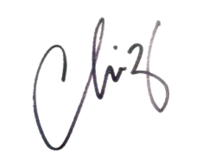

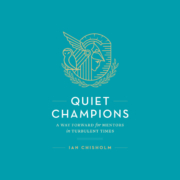
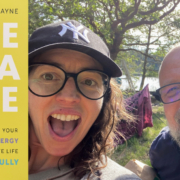

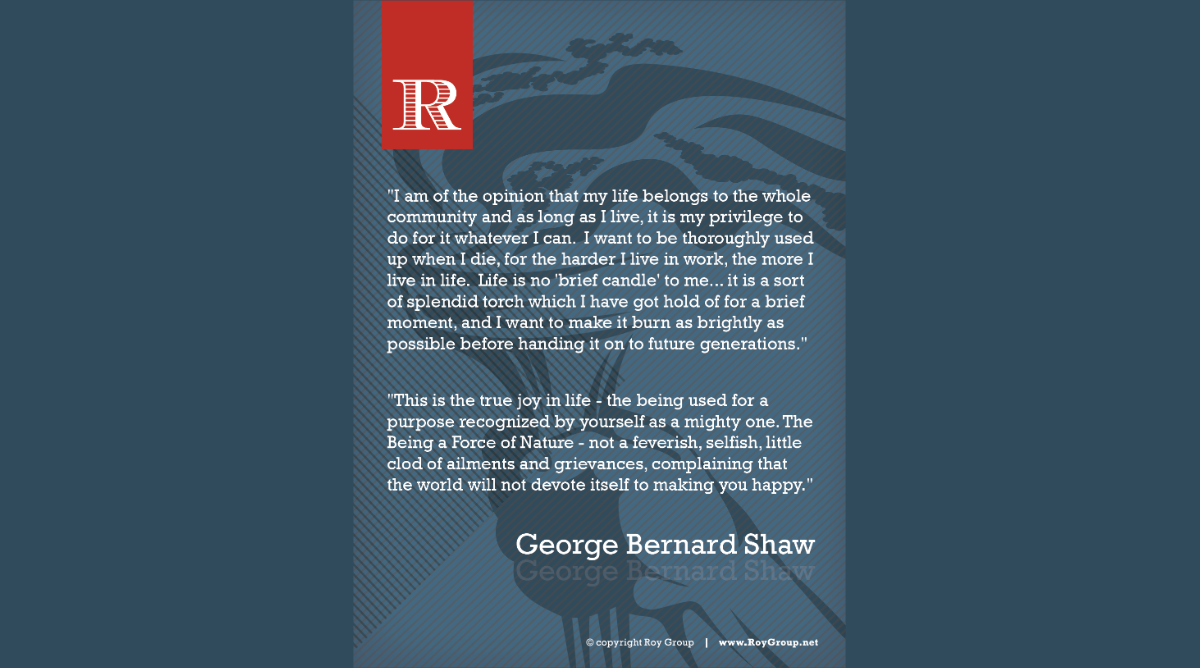
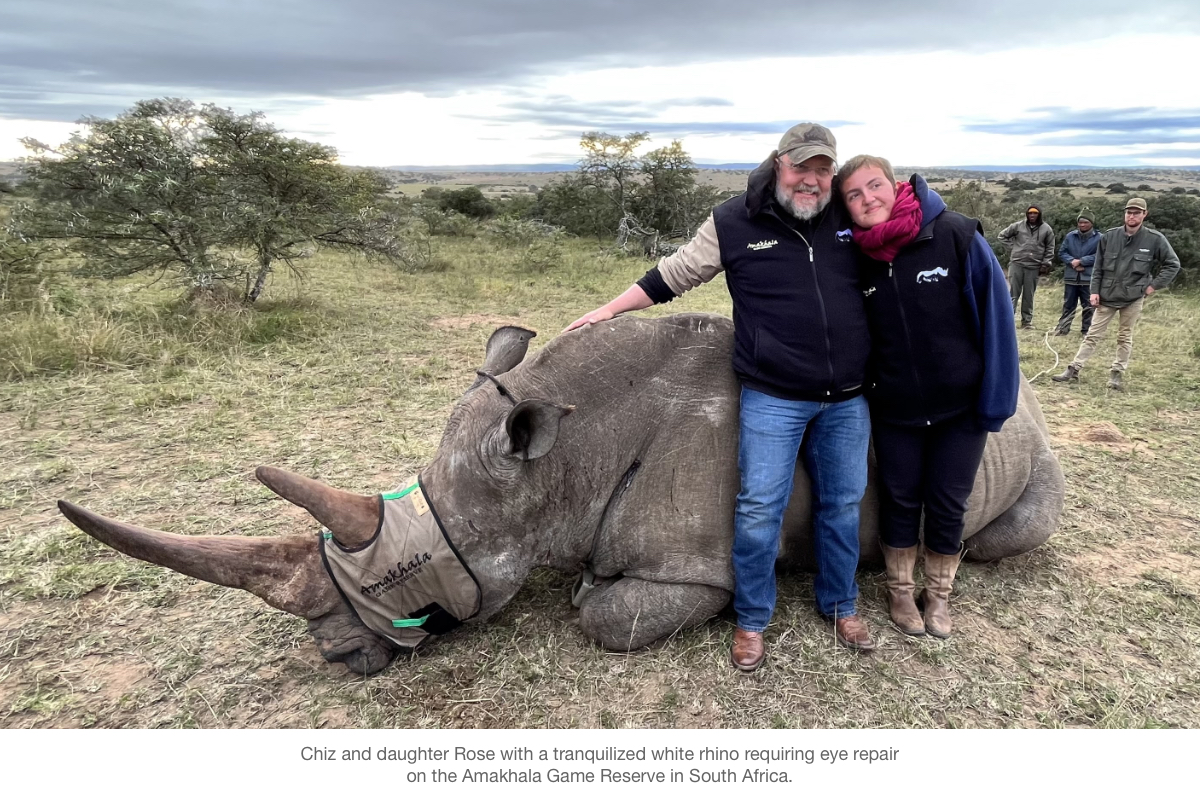
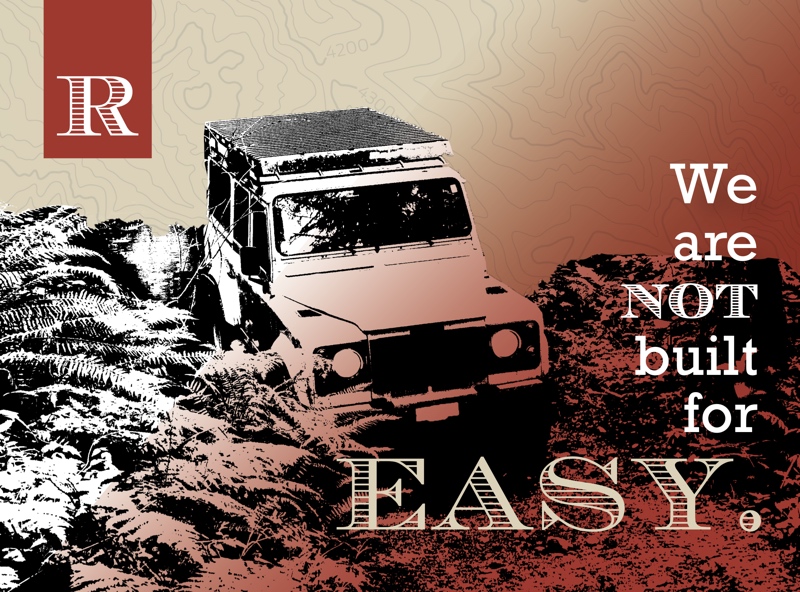


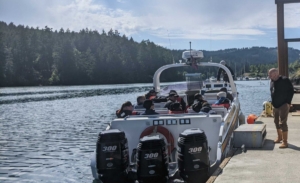
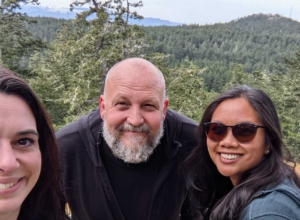
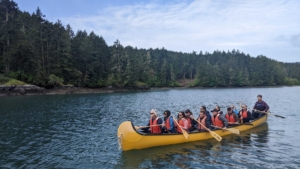
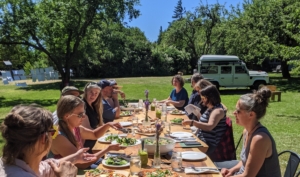
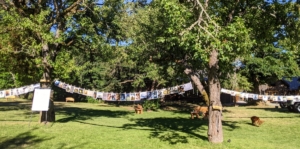
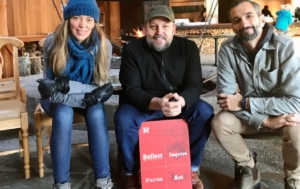
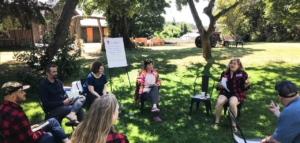
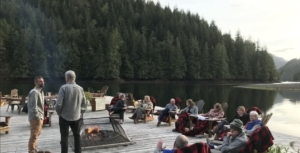
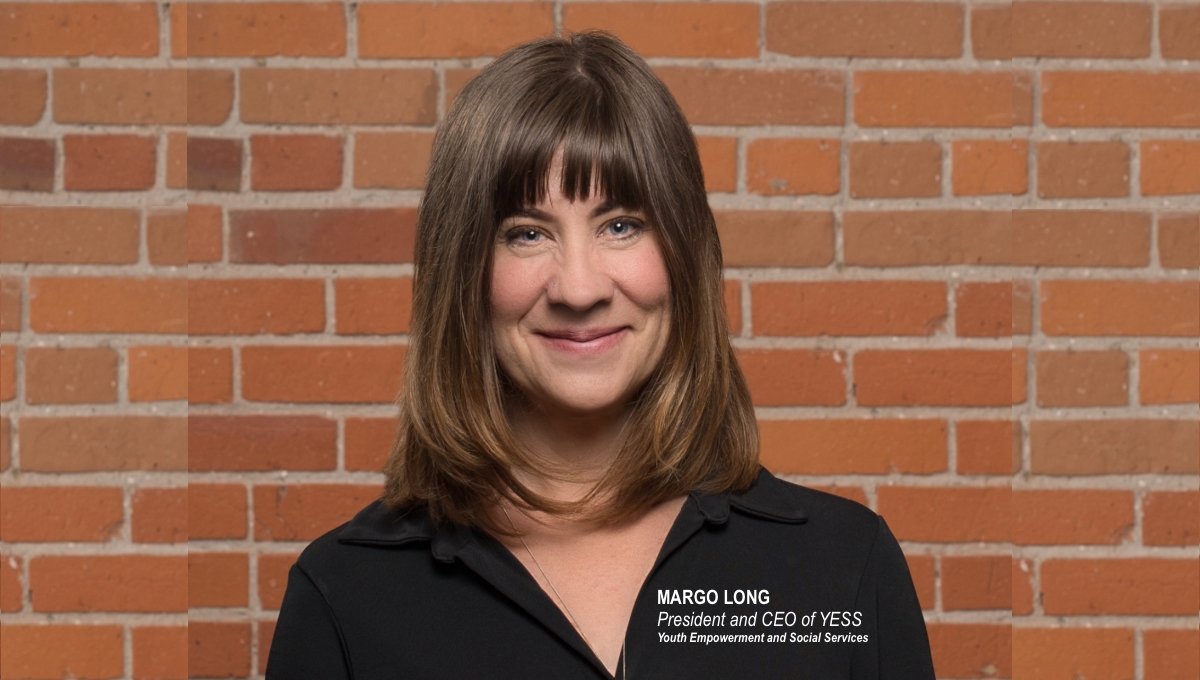
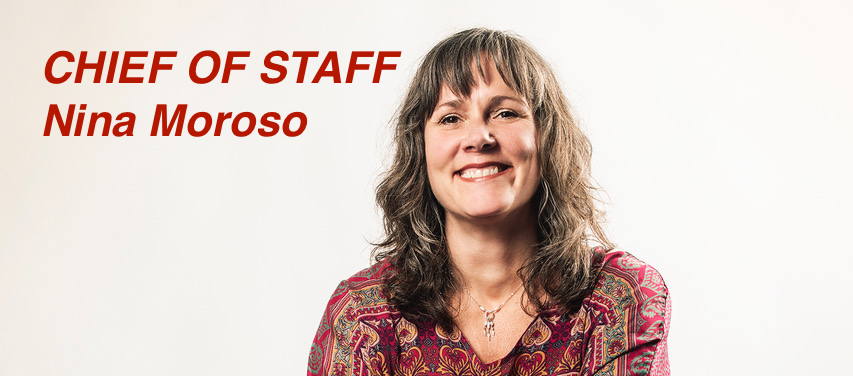

 Photo by Dave Contreras on Unsplash
Photo by Dave Contreras on Unsplash 